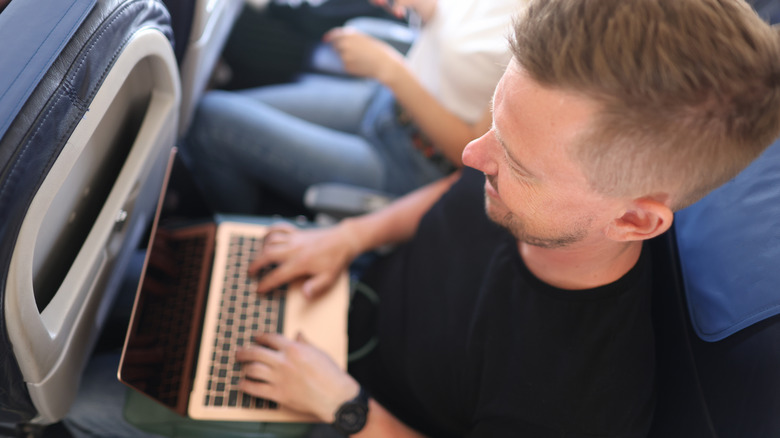How To Enable Airplane Mode On macOS
Most electronic devices are built-in with quick controls that let you shut off connectivity so that you can still use them safely on an airplane. According to the Federal Aviation Administration (FAA), passengers with portable electronic devices like mobile phones and other items that utilize cellular connectivity are prohibited from using them on the plane to minimize their potential for impeding the function of essential aircraft navigation equipment. However, when cellular is disabled, certain devices like smartphones, tablets, or e-readers are permitted for airborne use and can connect to Wi-Fi if the airline offers the service. Using personal laptops for in-flight entertainment is allowed as well, but because of their physical size, FAA requires that they be stowed away during taxi, takeoff, landing, and emergencies so they don't interfere with evacuation protocols.
In general, the need to switch devices to airplane mode is to ensure that they don't constantly search for connections with cell towers on the ground. In addition, airplane mode can also stop mobile devices from trying to detect GPS signals. When employed during airplane travel, this is a catch-all feature that ensures flight procedures are unaffected by any potential electronic disruptions and is also a great way to preserve battery life. Moreover, switching to airplane mode is an effective troubleshooting method that fixes common mobile device glitches.
Airplane mode for iPhones and the like can be easily turned on with a quick tap of a button. Is there a similar easy-access switch available for MacOS laptops? The quick answer is no — although some Windows laptops do have the feature available, Mac computers don't come with GPS chips and don't support cellular connectivity, which would make an airplane mode switch unnecessary. However, there is a way to mimic some of the service disconnections that happen on Mac computers.
You'll need to turn off Wi-Fi and Bluetooth connectivity separately
Most people enable airplane mode as a quick way to turn off wireless features on their smartphones and other mobile devices. On MacOS, you can accomplish something similar by manually disabling Wi-Fi, Bluetooth, or both. Here's how:
- On your Mac computer, click the Apple menu. It's the apple icon in the top-left corner of the screen.
- Go to System Settings.
- On the left side panel, select Wi-Fi. Next to Wi-Fi, switch the toggle to the off position to turn it off.
- To do the same for Bluetooth, pick Bluetooth from the side panel of the System Settings window and switch the Bluetooth toggle off.
Alternatively, you may also have quick access buttons that'll allow you to turn off either or both features. Look in the top-right corner of your Mac computer's main navigation bar and click on the Wi-Fi and Bluetooth icons to disable them.
If you're using your Macbook on an airplane when the flight attendants give you the go-ahead, turning off Bluetooth may not be necessary to "enable airplane mode" on your laptop. In fact, these days, most airlines offer Wi-Fi access while airborne, so you may not even need to turn that off either. However, disabling these features when they're not needed may be a good way to minimize battery use, which could be essential for long flights. Furthermore, if you're diagnosing a problem on MacOS and would like to try the airplane mode route to try and fix it, the steps above would be a good way to imitate the functionality.

